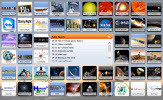August 2018
This month, unlike the month of July when viewing all naked-eye visible planets was possible, will still 'offer' visible planets, but not as well as last month. Mercury moves into inferior conjunction on the 9th and will not become visible until the last week of the month when it appears above the western horizon at sunset as an evening planet. The position of Venus over the western horizon at sunset is gradually gets lower this month as Venus moves toward eastern elongation on the 17th. Dwarf Planet Ceres, at 8th magnitude this month is low over the western horizon at sunset local time. Mars continues its retrograde until the 28th when it resumes direct, eastward motion. Jupiter is visible but is low over the western horizon at sunset. Saturn is above the southern horizon at sunset local time.
Click here for the month at a glance calendar.
 ---
---
Mercury starts this month moving into and then through inferior conjunction, between us and the Sun, by August 9th. By the end of August Mercury will reappear in the morning skies and will reach western elongation on the 21st.
Venus is visible over the western horizon at sunset. This inner planet is steadily moving eastward away from the Sun toward its eastern elongation during on the 16th.
Mars is visible over the eastern horizon at sunset local time and remains visible the rest of the night hours setting before sunrise. Mars ends its retrograde motion at the end of this month, resuming its regular prograde or eastward motion.
Dwarf Planet Ceres is over the southwestern horizon at sunset and is about 13o to the right of Venus. Ceres currently is only visible with an optical aid since it has an apparent magnitude of 8.07, which contrasts sharply with the -4.31 apparent magnitude of Venus.
Jupiter is visible over the southwestern horizon at sunset and sets 2-3 hours later.
Saturn is visible over the southeastern horizon after sunset and remains visible during the remaining night hours, setting 2-3 hours before the Sun rises.












 Above the Solar System at 10 day Intervals
Above the Solar System at 10 day Intervals

 Lee's Summit, MO
Lee's Summit, MO 